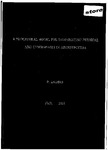A PROCEDURAL MODEL FOR INTEGRATING PHYSICAL AND CYBERSPACES IN ARCHITECTURE
| dc.contributor.author | Anders, Peter | |
| dc.contributor.other | Faculty of Science and Engineering | en_US |
| dc.date.accessioned | 2012-08-01T10:32:28Z | |
| dc.date.available | 2012-08-01T10:32:28Z | |
| dc.date.issued | 2003 | |
| dc.identifier | Not available | en_US |
| dc.identifier.uri | http://hdl.handle.net/10026.1/1060 | |
| dc.description.abstract |
This dissertation articiilates opportunities offered by architectural computation, in particular the digital simulation of space known as virtual reality (VR) and its networked, social variant cyberspace. The thesis will argue that VR/cyberspace has exacerbated differences between architecture's materialist and idealist practices, widening the gap that separates them. In an effort to bridge this gap it presents a procedural model for how VR and cyberspace may be integrated within the practice and product of architecture. The dissertation presents important developments in architectural computation that disclose concepts and values that contrast with orthodox practice. Virtual reality and cyberspace, the foci of this inquiry, are seen to embody the more problematic aspects of these developments. They also raise a question of redundancy: If a simulation is good enough, do we still need to build? This question, raised early in the 1990's, is explored through a thought experiment - the Library Paradox - which is assessed and critiqued for its idealistic premises. Still, as technology matures and simulations become more realistic the challenge posed by VR/cyberspace to architecture only becomes more pressing. If the case for virtual idealism seems only to be strengthened by technological and cultural trends, it would seem that a virtual architecture should have been well established in the decade since its introduction. Yet a history of the virtual idealist argument discloses the many difficulties faced by virtual architects. These include differences between idealist and professional practitioners, the failure of technology to achieve its proponents' claims, and confusion over the meaning of virtual architecture among both architects and clients. However, the dissertation also cites the success of virtual architecture in other fields - Human Computer Interface design, digital games, and Computer Supported Collaborative Work - and notes that their adoption of space derives from practice within each discipline. It then proposes that the matter of VR/cyberspace be addressed from within the practice of architecture, a strategy meant to balance the theoretical/academic inclination of previous efforts in this field. The dissertation pursued an assessment that reveals latent, accepted virtualities in design methodologies, instrumentation, and the notations of architectural practices. Of special importance is a spatial database that now pervades the design and construction processes. The unity of this database, effectively a project's cyberspace, and its material counterpart is the subject of the remainder of the dissertation. Such compositions of physical and cyberspaces are herein called cybrids. The dissertation examines current technologies that cybridize architecture and information technology, and proposes their integration within cybrid wholes. The concept of cybrids is articulated in seven principles that are applied in a case study for the design for the Planetary Collegium. The project is presented and critiqued on the basis of these seven principles. The dissertation concludes with a discussion of possible effects of cybrids upon architecture and contemporary culture. | en_US |
| dc.description.sponsorship | Planetary Collegium (CAiiA-STAR) | en_US |
| dc.language.iso | en | en_US |
| dc.publisher | University of Plymouth | en_US |
| dc.title | A PROCEDURAL MODEL FOR INTEGRATING PHYSICAL AND CYBERSPACES IN ARCHITECTURE | en_US |
| dc.type | Thesis | |
| dc.identifier.doi | http://dx.doi.org/10.24382/4217 |
Files in this item
This item appears in the following Collection(s)
-
01 Research Theses Main Collection
Research Theses Main


